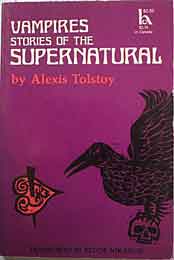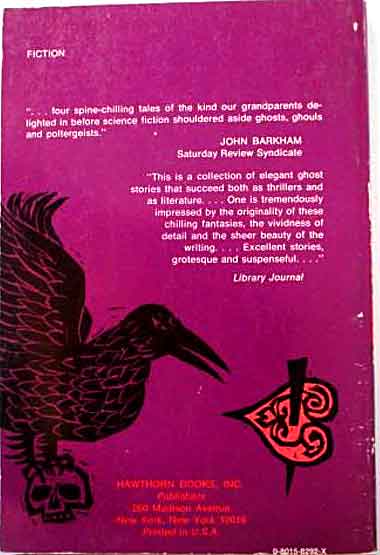By ALEXIS TOLSTOY (Hawthorn Books; 1969)
This long out of print anthology contains four stories, written in French by the Russian Alexis—or Aleksey— K. Tolstoy (1817-75), a cousin of two iconic writers: Leo Tolstoy and another Aleksey (Aleksey N. Tolstoy of AELITA: QUEEN OF MARS). The Alexis/Aleksey Tolstoy under discussion wasn’t known for horror fiction, but turned out some powerful examples of such (although, contrary to what the title portends, only two of this book’s four stories are actually vampire-themed).
The most famous, and widely anthologized, of Alexis Tolstoy’s horror stories was “The Family of A Vourdalak,” a translation of which, by Fedor Nikanov, is contained here. It’s not the best available English version of this story (I’ve found several online, bearing the title “The Family of The Vourdalak,” that surpass it) but does its job, rendering the flow of Tolstoy’s narrative with undeniable verve.
Related is a chilly and disquieting depiction of familial vampirism, as witnessed by the Marquis d’Urfe, an aging Frenchman who as a young man found himself caught up in a drama of suspicion and seduction in a Serbian village. FYI, the vamps here are referred to as vourdalaks, a type of vampire that confines its blood drinking to relatives.
More atmospheric apprehension is contained in “The Vampire,” a novella length account of another family of vamps, given yet another eastern-centric name: Oupyrs, referring to the critters’ Slavic origins (with “vampire” dubbed a “latinized version” of oupyr). The tale is told, once again, from the point of view of a young man caught up in an undead drama. That young man is Runevsky, who becomes drawn into an unholy clan by his love for Dasha, who closely resembles a woman depicted in a portrait hanging in her family’s mansion.
The remaining stories, “The Reunion After Three Hundred Years” and “Amena,” are pretty slight. The former involves a young woman lured into a ghostly banquet set in the ruins of a castle, and is most effective for the disarmingly nonchalant manner in which it concludes, while the latter is an ancient Rome set account of a man whose life is upended by a seductive demoness. Neither story has been made widely available in English (outside this book), and, frankly, there’s a reason for that.


